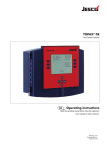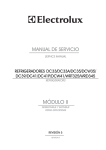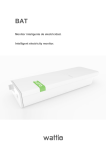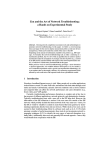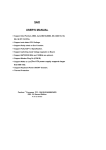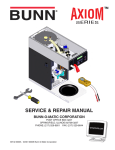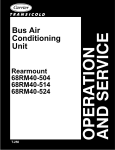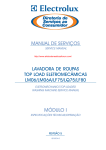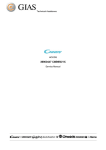Download Electrolux DF36 Service manual
Transcript
LÍDER MUNDIAL EM ELETRODOMÉSTICOS SERVICE MANUAL REFRIGERATOR DF36 MODULE I TABLES AND SPECIFICATIONS REVISION 0 CONTENTS 1. GENERAL INFORMATION ................................................................................................................. 3 1.1 Produced Model ............................................................................................................................... 3 1.2 Commercial Code Description .......................................................................................................... 3 1.3 Identification Tag ............................................................................................................................... 4 2. PRODUCT SPECIFICATIONS ........................................................................................................... 5 3. COMPONENTS SPECIFICATIONS ................................................................................................... 6 4. COOLING FLUID CIRCULATION SCHEMATIC DIAGRAM ................................................................ 7 5. COLD AIR FLOW SCHEMATIC DIAGRAM ....................................................................................... 8 6. OPERATION ...................................................................................................................................... 9 6.1 Defrost ........................................................................................................................................ 9 6.2 Compensation in Case of Power Failure .................................................................................... 10 This document cannot be reproduced or passed to third parties without authorization from Electrolux do Brasil S.A. 2 1. GENERAL INFORMATION 1.1 Produced Model FROST FREE REFRIGERATOR MODEL COMMERCIAL CODE Frost Free Refrigerator DF36 02344FEA306 02344FUA306 02344FFA306 02344FDA306 02344FHA306 02344F6A206 02344FQA106 MODEL CODE PNC PRODUCTION START DF36 925026275 925026278 925026279 925026280 925026281 925026282 925026283 June/2004 1.2 Commercial Code Description The commercial code is printed in an identification tag localized inside the refrigerator cabinet (left side) containing the following data: a. Product line: 02 – Two door refrigerator Curitiba unit e. Voltage/frequency: 1 - 127V/60Hz 2 - 220V/60Hz 3 - 220V/50Hz b. Capacity: 34 – 346 liters f. Product versiob: A – 1st version B – 2nd version C – 3rd version and so on c. Number and type of doors: 4 – door with right opening d. Produc type: F – Frost Free g. Market: Indicates whether the product is for the internal market (B) or the external one (another letter or number). 02 34 4 F E A 3 a. Product line e. Voltage/frequency b. Capacidaty (liters) f. Product version c. Right opening door g. Market d. Product type Example: 02 – Two doors refrigerator (combined) Curitiba unit 34 – 346 liters 4 – Hinges on the left side F – Frost Free E – Argentinean market A – Version A (1st version) 3 – 220V/50Hz Note: The example above only shows how to identify in the tag the code field. This document cannot be reproduced or passed to third parties without authorization from Electrolux do Brasil S.A. 3 1.3 Identification Tag The Electrolux products are identified through a tag on the appliance which contains valuable information for the Authorized Maintenance Service. 06 42812345 VOL. TOTAL BRUTO 346 VOL. ESTOC. CONG. 70 CLASSE MERCADO TE VOL. ESTOC REFRIG. PRESSÃO DE ALTA - BAIXA Serial Number Eight digits indicating the year, week of production and a sequential number, according to the following pattern = YWWSSSSS, where Y = last digit of the year; WW = week when the product was built; SSSSS = a production sequential number for the week. 276 GAS FRIGOR. R134a CORRENTE 1,1A 175,0 - -3,0 psig CARGA DE GAS 110g POTENCIA 123W FAIXA TENSAO 198 - 242 V~ Gross Total Volume Four digits indicating the product’s declared volume. CAPACID. CONG. ELC NORMA 5155 RESIST. DESCONG. FREQUENCIA 50 6,0 kg/24h 42812345 Nº DE SERIE COR Nº DE SERIE Type A maximum of 60 alphanumeric digits, indicating the model and specifications of the product. 02344FEA306 REFRIGERADOR DUAS PORTAS DOMÉSTICO CÓDIGO COMERCIAL 02344FEA3 TIPO 220 V~ DF36 E Color Two digits indicating the product’s color: 06 - white MODELO CÓDIGO COMERCIAL DF36 TENSÃO MODELO 50 ELECTROLUX DO BRASIL S.A CURITIBA - PR - INDUSTRIA BRASILEIRA C.N.P.J. 76.487.032.0001-25 PROCESSO INTERNO Commercial Code Nine alphanumeric digits referring to the product’s commercial code. MERCADO Model Model DF36 Volumetric Capacity of the Freezer Four digits indicating the freezer’s volumetric capacity. Volumetric Capacity of the Refrigerator Four digits indicating the volumetric capacity of the refrigerator. Class Letter indicating the product’s climate class (T class - Tropical). Market Letter identifying the market. High Pressure Three digits indicating the refrigeration system pressure. Cooling Gas A maximum of five alphanumeric digits indicating the name of the cooling gas used in the refrigeration system. Gas Charge A maximum of four digits indicating the charge in grams of cooling gas loaded in the product’s refrigeration circuit. Current This field contains a maximum of two digits followed by one decimal indicating the product’s working current. Potency A maximum of four digits indicating the electric power to be absorbed by the product. This document cannot be reproduced or passed to third parties without authorization from Electrolux do Brasil S.A. 4 2. PRODUCT SPECIFICATIONS MODEL CODE D F 36 TYPE REFRIGERATOR / FREEZER TWO DOORS PRODUCT DIMENSIONS (mm) WIDTH 600 DEPTH 745 HEIGHT PACKAGED PRODUCT DIMENSIONS (mm) 1725 WIDTH 640 DEPTH 760 HEIGHT NOMINAL CAPACITY (litros) 1775 FREEZER 70 REFRIGERADOR 276 TOTAL 346 FREEZING CAPACITY 6 kg/24h NET WEIGHT (kg) 66 GROSS WEIGHT (kg) 68 REFRIGERANT GAS R134a GAS CHARGE (g) 110 ± 5 ELECTROMECHANIC TIMER (EVERY 8 HOURSOF COMPRESSOR OPERATION) DEFROST HIGH PRESSURE (psig) 210 (STABILIZED REGIME PRESSURE) LOW PRESSURE (psig) -1 (STABILIZED REGIME PRESSURE) CLASSIFICATION POWER CONSUMPTION (kWh/MONTH) 3 STARS 127/220V - 60Hz 55,6 220V - 50Hz 37,9 INTERNAL LAMP (15W) 1 IN THE REFRIGERATOR PARTS & ACCESSORIES PRODUCT LEVELING 2 FRONT LEGS This document cannot be reproduced or passed to third parties without authorization from Electrolux do Brasil S.A. 5 3. ESPECIFICAÇÕES DE COMPONENTES MODEL D F 36 02344FQA106 02344F6A206 02344FEA306 02344FUA306 02344FFA306 02344FDA306 02344FHA306 VOLTAGE (V) / FREQUENCY (Hz) 127 / 60 220 / 60 220 / 60 VOLTAGE RANGE (V) 103 - 135 198 - 242 198 - 242 POTENCY (W) 133 130 123 CURRENT (A) 2,0 1,0 1,1 EG 75HLR EG 75HLR EG 75HLR COMMERCIAL CODE MODEL R E F R C Y C L E START TYPE COMPRESSOR AMPERIMETRIC RELAY OIL TYPE ISO 10 RESISTANCE AT AUXILIARY +25ºC MAIN 7,1 43,10 2,8 10,35 EVAPORATOR FLAP TUBE CONDENSER EXTERNAL DRYING FILTER 10,35 MOLECULAR SIEVE (XH9 - 19g) CAPILLARY PIPE I.D. 0,75 x 2490mm CAPACITY 120 / 240 VAC FLA6 LRA 36 THERMOSTAT MODEL TSV 5001-09 OPEN AT 25ºC ± 3ºC CLOSE AT -6ºC ± 4ºC DEFROST THERMOSTAT (BIMETAL) N14 KSD 303A E L E C T R I C 72ºC ± 4ºC COMPRESSOR CLOSING TEMPERATURE(ºC) THERMAL PROTECTOR OPENING TEMPERATURE (ºC) 70 - 52 70 - 52 70 - 52 110 - 120 100 - 110 100 - 110 8 8 8 107 377 377 POTENCY (W) 255 ± 7,5 255 ± 7,5 255 ± 7,5 RESISTANCE (Ω) AT 23ºC 57,9 - 70,3 180,8 - 210,9 180,8 - 210,9 14 14 14 1152 ± 5% 3457 ± 5% 3457 ± 5% 15 15 15 POTENCY (W) MOTORFAN D E T A I L S A C 250V / 10A DEFROST CAPACITY AND OPERATION THERMAL FUSE TEMPERATURE DEFROST RESISTANCE GUTTER RESISTANCE RESISTANCE (Ω) AT 25ºC POTENCY (W) RESISTANCE (Ω) AT 25ºC LAMP POTENCY (W) DOOR SWITCH 250V / 0,5A 11.800Ω ± 2.360Ω ELECTROMECHANIC TIMER (RESISTANCE) AT 25ºC NOT MEASURABLE WITH A OMMETER This document cannot be reproduced or passed to third parties without authorization from Electrolux do Brasil S.A. 6 4. COOLING FLUID CIRCULATION SCHEMATIC DIAGRAM Compressor – Evaporation Coil - Condenser – Dehumidifier Pipe – Drying Filter – Capillary Pipe - Evaporator – Suction Accumulator – Suction Line - Compressor Evaporator Suction line Dehumidifier pipe Condenser Capillary pipe Drying filter Compressor Evaporation coil This document cannot be reproduced or passed to third parties without authorization from Electrolux do Brasil S.A. 7 5. COLD AIR FLOW SCHEMATIC DIAGRAM The cold air generated in the evaporator is forced into the freezer compartment and into the refrigerator compartment by the motofan. In the freezer compartment the cold air is distributed through the top flow to the shelves and the food is frozen by the cold air flow. In the refrigerator compartment, the cold air flow coming from the evaporator is carried by the freezer’s top flow passing through the manual damper that will control the amount (flow rate) of cold air that will be redirected to cool down the refrigerator compartment. The manual damper has three positions: · Maximum Refrigerator: 80% of the air flow rate is redirected to the refrigerator implying in a faster cooling rate in the refrigerator compartment. · Normal: 50% of the air flow rate is redirected to the refrigerator. · Maximum Freezer: only 20% of the air flow rate is redirected to the refrigerator thus implying in a slower cooling rate in the refrigerator compartment. Refrigerator's air return (detail) Refrigerator's air return After passing through the manual damper, the cold air flow will be carried through a space in the intermediary division between the freezer and the refrigerator compartments to the top flow duct of the refrigerator that will then uniformly distribute it through that compartment. After cooling down the refrigerator compartment the air will return through the refrigerator’s Top Flow back, which will direct it through another space in the intermediary division between the freezer and refrigerator compartments, to the freezer’s evaporator. Motorfan Cover with air outlets Evaporator Multiflow Freezer Air outlets Freezer's Top Flow Air return Refrigerator's Top Flow Detail of Refrigerator's Air return This document cannot be reproduced or passed to third parties without authorization from Electrolux do Brasil S.A. 8 6. OPERATION The DF36 Electromechanical Frost Free refrigerator works under the vapor compression cycle R134-a. The vapor is compressed in the alternate compressor, release heath in the condenser, is restricted into the capillary pipe and absorbs heath in the flap tube evaporator, returning to the compressor as vapor through the suction line. The cold air coming form the evaporator is forced by the motofan into the freezer and then conducted to the refrigerator through the freezer and refrigerator top flow ducts. The temperature control in the refrigerator is done with the help of an electromechanical thermostat located inside the top flow of this compartment which, in accordance to the temperature, varies its diaphragm turning off or on the power for the compressor, timer, and evaporator motofan. The temperature in the freezer compartment depends on the thermostat localized inside the refrigerator compartment which will be controlling the temperature of that compartment. As the refrigeration need of the refrigerator compartment is greater than the one of the freezer compartment, having the temperature control located in the refrigerator compartment guarantees that the freezer will always be operating in an adequate temperature (below -18ºC). A greater refrigeration speed between the both compartments can be controlled through the mechanical damper localized in the freezer’s top flow, which has three possible, adjust positions: maximum refrigerator, normal, and maximum freezer. 6.1 Defrost After cooling for some time, all the humidity introduced inside the product by the stored food, or by the opening of the doors, will be retained in the evaporator and will gradually freeze. At that point, it will be necessary to remove this ice in excess accumulated on the surface of the evaporator, through a defrost operation. The product has a defrost resistance fixed to the evaporator and another resistance fixed to the defrost drain gutter, localized in the refrigerator’s top flow, so as to prevent the freezing of the gutter thus facilitating the draining of the water resulting from the defrost that comes from the evaporator. The evaporator and the gutter resistances’ are connected in parallel. During the defrost operation, the compressor, the motofan and the timer will remain turned off. The resistances are turned on by the timer, with the monitoring of the defrosting end being done by the defrost thermostat (bimetal). There is a thermal security fuse positioned in the up right side of the evaporator. Note: The thermal fuse works in the case of a failure in one of the other circuits thus avoiding the defrost resistance to heat too much. In case the thermal fuse is used it will be spoiled. Before replacing that component, it’s mandatory that the problem that led to its use should have been identified and fully corrected. The product must never be turned on without the thermal fuse being correctly installed. 6.1.1 Defrost Bimetal registering a temperature equal to or above +25°C ( ±3ºC) when the refrigerator is turned on: Accumulates 8 hours of compressor operation Pause (10min) (dripping with the resistances already turned off) Defrost (up to +25ºC in the Bimetal) This document cannot be reproduced or passed to third parties without authorization from Electrolux do Brasil S.A. 9 6.1.2 Defrost Bimetal registering a temperature less than -6ºC (±4ºC) when the refrigerator is turned on (in the case of a power failure happening before the product has achieved a temperature above +25ºC (3 ºC) in the defrost bimetal). Accumulates 8 hours, considering the time accumulated befor the turn off Pause (10min) (dripping with the resistances already turned off) Defrost (up to +25ºC in the Bimetal) 6.1.3 During the continuous operation of the refrigerator Accumulates 8 hours of compressor operation Defrost (up to +25ºC in the Bimetal) Pause (10min) (dripping with the resistances already turned off) 6.2 Compensation in Case of Power Failure In case of power failure, the product will behave according to the following conditions once the power returns. 6.2.1 Defrost Bimetal registering a temperature equal to or above +25ºC The product will restart operation according to the procedure in item 6.1.1. 6.2.2 Defrost Bimetal registering a temperature lesser than -6ºC The product will preserve the same adjustment configuration it has before the power failure. The defrost will happen according to item 6.1.2. ELECTROLUX DO BRASIL S.A. Rua Ministro Gabriel Passos, 360 Caixa Postal 16201 CEP 81 520900 Curitiba Paraná Brasil Tel/Fax (041) 371 7000 http://disc.electrolux.com.br Customer Care Center Elaboration: Service Engineering July/2004 Revision 0 This document cannot be reproduced or passed to third parties without authorization from Electrolux do Brasil S.A. 10 LÍDER MUNDIAL EM ELETRODOMÉSTICOS SERVICE MANUAL REFRIGERATOR DF36 MODULE II ASSEMBLING AND DISASSEMBLING OF THE REFRIGERATOR/FREEZER REVISION 0 CONTENTS 1. TOOLS AND EQUIPMENT REQUIRED FOR THE PRODUCT MAINTENANCE ......................................... 3 2. DISASSEMBLING OF THE FREEZER ...................................................................................................... 2.1 Access to the Freezer Components .................................................................................................... 2.2 Access to the Refrigerator Components .............................................................................................. 2.3 Removal of the Top Flow Assemblage ................................................................................................. 2.4 Removal of the Air Duct and Gutter ..................................................................................................... 2.5 Removal of the Thermostat .................................................................................................................. 2.6 Disassembling of the Door Handle ....................................................................................................... 2.7 Removal of the Doors .......................................................................................................................... 2.8 Replacement of the Motofan ................................................................................................................ 2.9 Disassembling of the Evaporator ......................................................................................................... 3 3 4 5 5 6 8 8 9 10 2.10 Removal of the Timer ......................................................................................................................... 12 This document cannot be reproduced or passed to third parties without authorization of Electrolux do Brasil S.A. 2 1. TOOLS AND EQUIPMENT REQUIRED FOR THE PRODUCT MAINTENANCE • Digital multimeter plier (Minipa ET 3200 A) • Curved-noose plier • Pipe-cutting plier (LRSZ –VULCAN)) • Cutting plier • Lokring plier (VULCAN) • Lockring joints 8 to 6, aluminum - copper • Screwdriver 1/4 x 6” • Phillips screwdriver 3/16 x 6" • Torx tools set • Digital Multimeter • Thermal-hygrometer (SUNDO) • Digital Thermometer with 4 sensors (Full Gauge) • Lokprep sealant 2. PRODUCT DISASSEMBLING 2.1 Access to the Freezer Components 2.1.1 Remove all the freezer accessories. 2.1.2 With a Phillips screwdriver, remove the top flow screws. 2.1.3 Remove the top flow assemblage by pulling it from the top. 2.1.4 With a Phillips screwdriver, remove the two screws so as to loose the cover. This document cannot be reproduced or passed to third parties without authorization of Electrolux do Brasil S.A. 3 2.1.5 Pull the cover as shown in the image below and disconnect the motofan. 2.1.6 Disconnect the motofan thermostat – it has a locking connector that should be pressed so as to be released. Note.: The removal of this cover can be hindered if the product is cold since then the ice can stuck it to the evaporator. Await a few minutes to remove the cover. 2.1.7 To assemble the components above just follow the assembling sequence backwards, with special care in relation to: - the proper positioning of the components, - the correct connection of the electrical terminals. 2.2 Access to the Refrigerator Components Remove the refrigerator compartment shelves, pulling them to the front until they stop. Raise them and pull them out. This document cannot be reproduced or passed to third parties without authorization of Electrolux do Brasil S.A. 4 2.3 Removal of the Top Flow Assemblage To remove the top flow assemblage located on the top of the refrigerator compartment, you should remove the two Phillips screws and carefully loose the assemblage from its supports in the back of the internal box. To finally remove the assemblage, unplug the six ways connector releasing its security lock. 2.4 Removal of the Air Duct and Gutter To remove the air duct, unplug the terminals of the thermostat and the light bulb, unlock the gutter from the top flow cover and pull the air duct up (see images bellow and on the next page). This document cannot be reproduced or passed to third parties without authorization of Electrolux do Brasil S.A. 5 2.5 Removal of the Thermostat Remove the air duct and pull the thermostat button out of the top flow. Release the thermostat from the fasteners that hold its body and spiral bulbous from the top flow casing. This document cannot be reproduced or passed to third parties without authorization of Electrolux do Brasil S.A. 6 Note: when replacing the thermostat by a new one, please pay attention to the bulbous fastening to the vertical groove on the top flow cover, locking the spiral bulbous in the casing. Attention: do not remove the plastic coat that covers the bulbous. 2.5.1 To replace the gutter resistance with the internal net, detach the ribbon that fixes the net to the air duct and release the top flow internal net from the fasteners. This document cannot be reproduced or passed to third parties without authorization of Electrolux do Brasil S.A. 7 2.6 Disassembling of the Door Handle 2.6.1 With the help of a screwdriver, remove the handle cover applying pressure from below so as not to scratch the surface. Pull the cover to the front, releasing it. 2.6.2 With the help of a Torx T30 tool, remove the screw and release the handle pulling it to the left to release the lock, and then to the front. 2.6.3 To assemble the door handle, please follow the same sequence previously described backwards. Note: whenever necessary to replace the handle, it’s also recommended to replace the handle cover since it can be damaged during the removal. 2.7 Removal of the Doors 2.7.1 Using a 1/4 x 6" Phillips screwdriver, loosen the two screws of the top hinge, and then lift the front part of the hinge so as to unfit it. 2.7.2 Carefully remove the freezer door, lifting and unfitting it from the intermediary hinge. Be careful not to lose the support plastic washer. 2.7.3 Using a T30 Torx tool, remove the intermediary hinge loosening its screws. 2.7.4 Remove the refrigerator door, lifting it and unfitting it from the bottom hinge. This document cannot be reproduced or passed to third parties without authorization of Electrolux do Brasil S.A. 8 2.8 Replacement of the Motofan 2.8.1 Follow the procedure described in item 2.1, Access to the Freezer Components. 2.8.2 With a cutting pliers, cut the fasteners that fix the motofan net on the evaporator cover. 2.8.3 With a needle-nose pliers, remove the propeller lock so as to release the propeller. 2.8.4 Remove the Phillips screw from the motofan cover and, with the help of a screwdriver, release the locks. 2.8.5 Remove the motofan motor. To re-assemble the motofan assemblage, please follow the same procedure backwards, using new fasteners to fix the electric cabling to the evaporator cover. Make sure that the motofan axle seals are correctly positioned. This document cannot be reproduced or passed to third parties without authorization of Electrolux do Brasil S.A. 9 2.9 Disassembling of the Evaporator (bimetal, thermal fuse and defrost resistance replacement) Evaporator Replacement (procedure for products outside the warranty period) 2.9.1 Follow the procedure described in item 2.1, Access to the Freezer Components. 2.9.2 Loosen the two Phillips screws that fix the evaporator to the internal box. Attention: Be careful not to drop the screws in the gutter bellow the evaporator or in the damper duct. If anything falls into one of these two components, it should be necessarily removed so as to preclude any operation failures with the product. 2.9.3 Collect the cooling gas (in case there is any in the unit). 2.9.4 Remove the rubber shock absorber form the suction line and, with the help of a LRSZ pliers, cut the pipes of the suction and the capillary lines next to the lockring ring. 2.9.5 Put the anaerobic Lokprep sealant in the suction/capillary lines pipes and in the entry and exit accesses of the evaporator. 2.9.6 Use the lockring joint to connect the evaporator pipe to the suction/capillary line. Uphold the evaporator to assure a pre-assembling with the joints. 2.9.7 With the help of a lockring pliers, close the lockring joints. 2.9.8 Pressurize the system with 120 lbf/pol2 so as to check if there are any leaks in the joints or in the accessible parts of the sealed unit. 2.9.9 No leaks being observed, re-operate the sealed unit. This document cannot be reproduced or passed to third parties without authorization of Electrolux do Brasil S.A. 10 2.9.10 To remove the Reflecting Gutter: • Unplug the connectors of the fuse-bimetal circuit and the resistance. • Pull the evaporator locks to release the reflecting gutter. 2.9.11 To replace the fuse-bimetal circuit: • Carefully turn the evaporator from the right to the left, as shown in the picture bellow. • Using a cutting pliers, remove the four plastic fasteners that fix the fuse-bimetal circuit to the evaporator. INSTALL THE NEW FUSE-BIMETAL CIRCUIT TAKING CARE TO POSITION IT THE SAME WAY THE ORIGINAL CIRCUIT WAS POSITIONED. FIX THE NEW CIRCUIT WITH PLASTIC FASTENERS CUTTING OFF THE EXCESS. This document cannot be reproduced or passed to third parties without authorization of Electrolux do Brasil S.A. 11 2.9.12 To replace the defrost resistance: • Release the metal fastener that fixes the resistance under the evaporator. • Release the resistance from the evaporator fittings. To install a new resistance, fit it in the evaporator fittings and then fix it with the metal fastener. 2.10 Removal of the Timer 2.10.1 With the help of a Phillips screwdriver, loosen the screw that fixes the box which contains the timer. 2.10.2 Carefully remove the box, unfitting it from the internal lateral side of the cabinet. 2.10.3 With a screwdriver, loosen the three fixing locks in the box so as to have access to the timer. To remove the timer, just remove the three screws fixing it to the box. ELECTROLUX DO BRASIL S.A. Rua Ministro Gabriel Passos, 360 Caixa Postal 16201 CEP 81 520900 Curitiba Paraná Brasil Tel/Fax (041) 371 7000 http://disc.electrolux.com.br Customer Care Center Elaboration: Service Engineering July/2004 Revision 0 This document cannot be reproduced or passed to third parties without authorization of Electrolux do Brasil S.A. 12 LÍDER MUNDIAL EM ELETRODOMÉSTICOS SERVICE MANUAL REFRIGERATOR DF36 MODULE III ELECTRICAL COMPONENTES TESTING REVISION 0 CONTENTS 1. TESTING PROCEDURES ......................................................................................................................... 1.1 How to know if the board is energized ............................................................................................... 1.2 Operation of the compressor and motofan ......................................................................................... 1.3 Operation of the bulbs ....................................................................................................................... 1.4 Operation of the defrost system ........................................................................................................ 3 3 3 4 5 2. ELECTRICAL COMPONENTS TESTING PROCEDURES ......................................................................... 2.1 Compressor ...................................................................................................................................... 2.2 Thermostat ....................................................................................................................................... 2.3 Timer ................................................................................................................................................ 2.4 Switch Test ....................................................................................................................................... 2.5 Bimetal Test ...................................................................................................................................... 7 7 7 8 8 9 This document cannot be reproduced or passed to third parties without authorization of Electrolux do Brasil S.A.. 2 1. TESTING PROCEDURES 1.1 How to know if the board is energized With the help of the digital multimeter, measure the alternate tension (127V or 220V) between the brown and blue wire terminals of the compressor, as indicated in the scheme below: 1.2 Operation of the compressor and motofan The control of the operation of the compressor and the motofan is done by the thermostat and timer. After the product is connected to the mains, verify if there is alternate tension (127V or 220V) between the brown and blue wire terminals and the pin 4 of the timer connector. Note: The motofan and the compressor operate both, simultaneously. The motofan is turned off by the doors switches when any one of them is opened. This document cannot be reproduced or passed to third parties without authorization of Electrolux do Brasil S.A.. 3 1.3 Operation of the bulbs To verify the proper operation of the bulb, measure the alternate tension (127V or 220V) between the terminal 1 of the thermostat and the terminal 4 of the multi-way connector of the refrigerator top flow. ! Thermostat test With the thermostat in the turned on position, it should have been continuity between the terminals 1 and 3. If there is no continuity, the thermostat must be replaced. This document cannot be reproduced or passed to third parties without authorization of Electrolux do Brasil S.A.. 4 1.4 Operation of the defrost system To check the operation of the product defrost system the steps bellow should be followed: 1.4.1 Forced Defrost With the help of a screwdriver, turn the timer mechanism in the clockwise sense until you hear the first click, so as to manually advance it to the defrost position. At this point, a change occurs in the timer contacts going from 1-4 to 1-2, turning off the product compressor. 1.4.2 Verify if there was change of the timer contacts which provide energy for the resistances. Now, there should be alternate tension (127 or 220V) between the contacts 1-2 of the timer. The freezer temperature being bellow -6 ± 4ºC, there will be current feeding the defrost and gutter resistances, which are connected in parallel. At this point, the timer motor stops, because being serially connected to the resistances it has an elevated impedance (approximately 16.000) in relation to the parallel value between the resistances. The current that flows through the circuit tend to follow the path with lesser resistance. The defrost operation is monitored by the bimetallic defrost thermostat. When the temperature achieves +25 ± 3 º C in the thermostat, its contact opens interrupting the current being passed to the resistances. At this point, the timer motor is energized again, resuming operation and turning the timer mechanism for 10 minutes. During this period of time, the product is still with contacts 1-2 on and the motofan, resistances and the compressor are turned off. We call this 10 minutes period of dripping time. After this period of time, there is a change in the timer contacts to 1-4, activating the compressor if the refrigerator thermostat is requiring its activation. 1.4.3 Checking the resistances with forced defrost ! Defrost Resistance Disconnecting the freezer evaporator defrost resistance male connector, using the resistance scale of the multimeter, it is possible to verify its resistance value in ohms (see the table bellow for comparison values). In the resistance female connector located in the cabinet, it is possible to measure the alternate tension127V or 220V), if the defrost is activated, according to the procedure described above. If there is tension in this connector, that means that the thermal fuse and the defrost thermostat are allowing the defrost operation. térmico e o termostato de degelo estão permitindo a operação de degelo. OHMIC RESISTANCE OF THE DEFROST RESISTANCE AT +23ºC FOR 127V FOR 220V 57,9 to 70,39 180,8 to 210,9 BRIDGE BETWEEN THE CONNECTORS* RESISTANCE MEASUREMENT POWER VOLTAGE MEASUREMENT WITH DEFORST IN OPERATION * Attention: The bridge (pink wire) between the evaporator resistance and the bimetal-fuse connectors should present continuity between them, otherwise there won’t be current to feed the defrost resistance. This document cannot be reproduced or passed to third parties without authorization of Electrolux do Brasil S.A.. 5 ! Gutter Resistance In the multi-way connector, located in the refrigerator top flow, it is possible to measure the ohmic resistance the tension of the current being fed to the gutter resistance. 1. In the refrigerator top flow male connector, measure the value of the ohmic resistance of the gutter resistance positioning the probing needles of the multimeter, already set to the resistance scale, on the terminals 5-6. OHMIC RESISTANCE OF THE GUTTER RESISTANCE AT +23ºC 1 2 3 6 5 4 FOR 127V FOR 220V 1094 to 1210 3284 to 3630 TOP FLOW MULTI-WAYS MALE CONNECTOR 2. In the top flow female connector, next to the cabinet, it will be possible to measure the alternate tension (127V or 220V) of the current being fed to the gutter resistance on terminals 5-6, while the product is defrosting. 1 2 3 6 5 4 TOP FLOW MULTI-WAYS FEMALE CONNECTOR 1.4.4 Checking the thermal fuse and the defrost thermostat With the digital multimeter adjusted to the continuity scale, check the thermal fuse and bimetal thermostat connector for the following points: IN TERMINALS 2-4 THERE SHOULD BE CONTINUITY TO GUARANTEE THE PROPER OPERATION OF THE THERMAL FUSE. 2 4 1 3 THERE SHOULD BE CONTINUITY BETWEEN TERMINALS 1-3 IF THE TEMPERATURE IN THE BIMETAL DEFROST THERMOSTAT IS BELOW -6°C WITH A VARIATION OF ±4°C. THERE WON’T BE CONTINUITY BETWEEN TERMINALS 1-3 IF THE TEMPERATURE IN THE BIMETAL DEFROST THERMOSTAT IS ABOVE +25°C WITH A VARIATION OF ±3°C. This document cannot be reproduced or passed to third parties without authorization of Electrolux do Brasil S.A.. 6 2. ELECTRICAL COMPONENTS TESTING PROCEDURES 2.1 Compressor Measure the terminals (C, S e R) with the digital multimeter set to the lesser scale of ohmic resistance, with the compressor at 25ºC. 127V/60Hz 220V/50-60Hz Between R and C 2,8 10,35 Between S and C 7,1 43,1 Between S and R 9,9 approx. 53,5 approx. 2.2 Thermostat Measure, with the help of the digital multimeter set to the continuity scale, the thermostat disconnected from the mains. Thermostat in the off position Thermostat in the on position THERMOSTAT THERMOSTAT There is continuity between pins 3-2, and 3-1. There is no continuity between pins 3-2, and 3-1. Thermostat turned off by temperature THERMOSTAT There is continuity between pins 3 and 1. There is no continuity between pins 3 and 2. This document cannot be reproduced or passed to third parties without authorization of Electrolux do Brasil S.A.. 7 2.3 Timer With the timer disconnected from the mains, measure with the help of the digital multimeter set to the continuity scale. Turn the timer cam with the help of a screwdriver until hearing the first click and then measure. Timer at defrost Timer turning on the compressor / motofan There is continuity between pins 1 and 2. There is no continuity between pins 1 and 4. Turn the timer cam with the help of a screwdriver until hearing the first click and then measure. There is continuity between pins 1 and 4. There is no continuity between pins 1 and 2. With the timer disconnected from the mains, measure the timer motor with the digital multimeter set to the ohmic resistance scale. 2.4 Switch test With the switch disconnected from the mains. Check with the help of the digital multimeter set to the continuity scale, the following points: Switch with the two doors closed. Switch with the two doors open. SWITCH SWITCH There is continuity between pins 1 and 3. There is no continuity between pins 1 and 4, 1 and 2 There is continuity between pins 1 and 2, and 1 and 4. There is no continuity between pins 1 and 3. This document cannot be reproduced or passed to third parties without authorization of Electrolux do Brasil S.A.. 8 Switch with the freezer door open. Switch with the refrigerator door open. SWITCH SWITCH There is continuity between pins 1 and 2. There is no continuity between pins 1 and 3, 1 and 4. There is continuity between pins 1 and 4. There is no continuity between pins 1 and 3, 1 and 2. 2.5 Bimetal test With the bimetal disconnected from the mains, using the digital multimeter set to the continuity scale to measure the following points: Bimetal wih closed contacts Bimetal with open contacts The bimetal will show continuity between its terminals if it is exposed to temperatures bellow -6°C, within a variation of ± 4°C from that reference value. The bimetal will not show continuity between its terminals if it is exposed to temperatures above +25°C, within a variation of ± 3°C from that reference value. This document cannot be reproduced or passed to third parties without authorization of Electrolux do Brasil S.A.. 9 ELECTROLUX DO BRASIL S.A. Rua Ministro Gabriel Passos, 360 Caixa Postal 16201 CEP 81 520900 Curitiba Paraná Brasil Tel/Fax (041) 371 7000 http://disc.electrolux.com.br Customer Care Center Elaboration: Service Engineering July/2004 Revision 0 This document cannot be reproduced or passed to third parties without authorization of Electrolux do Brasil S.A.. 10 LÍDER MUNDIAL EM ELETRODOMÉSTICOS SERVICE MANUAL REFRIGERATOR DF36 MODULE V TROUBLESHOOTING REVISION 0 CONTENTS 1. TROUBLESHOOTING .............................................................................................................................. 3 1.1 Product does not turn on ......................................................................................................................... 3 1.2 Refrigerator bulbs switch on only when the compressor is running ........................................................... 4 1.3 Product does not freeze .......................................................................................................................... 5 1.4 The refrigerator compartment does not cool down .................................................................................... 7 1.5 Water leakage ......................................................................................................................................... 8 1.6 Blocked evaporator .................................................................................................................................. 9 1.7 Bulb does not switch on .......................................................................................................................... 11 This document cannot be reproduced or passed to third parties without authorization of Electrolux do Brasil S.A. 2 1. TROBULESHOOTING 1.1 Product does not turn on This document cannot be reproduced or passed to third parties without authorization of Electrolux do Brasil S.A. 3 1.2 Refrigerator bulbs switch on only when the compressor is running. This document cannot be reproduced or passed to third parties without authorization of Electrolux do Brasil S.A. 4 1.3 Product does not freeze. This document cannot be reproduced or passed to third parties without authorization of Electrolux do Brasil S.A. 5 1.3 Product does not freeze (continuation) This document cannot be reproduced or passed to third parties without authorization of Electrolux do Brasil S.A. 6 1.4 The refrigerator compartment does not cool down. This document cannot be reproduced or passed to third parties without authorization of Electrolux do Brasil S.A. 7 1.5 Water leakage This document cannot be reproduced or passed to third parties without authorization of Electrolux do Brasil S.A. 8 1.6 Blocked evaporator This document cannot be reproduced or passed to third parties without authorization of Electrolux do Brasil S.A. 9 1.6 Evaporador bloqueado (continuação) This document cannot be reproduced or passed to third parties without authorization of Electrolux do Brasil S.A. 10 1.7 Bulb does not switch on. This document cannot be reproduced or passed to third parties without authorization of Electrolux do Brasil S.A. 11 1.7 Bulb does not switch on (continuation). ELECTROLUX DO BRASIL S.A. Rua Ministro Gabriel Passos, 360 Caixa Postal 16201 CEP 81 520900 Curitiba Paraná Brasil Tel/Fax (041) 371 7000 http://disc.electrolux.com.br Customer Care Center Elaboration: Service Engineering July/2004 Revision 0
















































